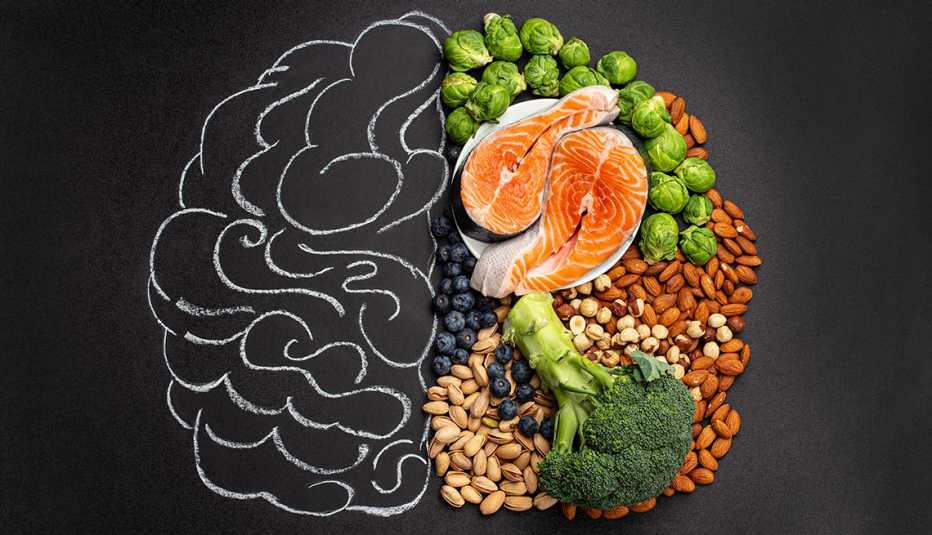Staying Fit


In 2004, a team of researchers at Rush University Medical Center enlisted a group of older adults who were participating in the ongoing Rush Memory and Aging Project (MAP) for a spin-off study. MAP began in 1997 with the goal of pinpointing the factors associated with memory loss in older adults, with an emphasis on Alzheimer’s Disease, the most common type of dementia. Researchers now wanted to zero in on diet; specifically, the effects of certain foods and nutrients as a preventive measure against Alzheimer’s.
Using past research, they developed a MIND diet score partially based on the Mediterranean and DASH (dietary approaches to stop hypertension) diets, both of which have been shown to benefit brain health. For nine years, participants agreed to keep track of what they ate and then fill out a dietary questionnaire at an annual cognitive assessment. At the end of that period, researchers found that participants with the highest MIND diet scores had a significantly slower rate of cognitive decline compared with those who had the lowest scores.


AARP Membership— $12 for your first year when you sign up for Automatic Renewal
Get instant access to members-only products and hundreds of discounts, a free second membership, and a subscription to AARP the Magazine.
Those initial findings, which were published in Alzheimer’s & Dementia: The Journal of the Alzheimer’s Association, provided the basis for the Mediterranean-DASH Intervention for Neurodegenerative Delay (MIND) diet.
What foods are allowed on the MIND diet?
What Do You Eat on MIND?
Eat From 10 Food Groups:
- Leafy green vegetables: at least six servings per week
- Other vegetables: at least one serving per day
- Berries: at least two servings per week
- Whole grains: at least three servings per day
- Fish: one serving per week
- Poultry: two servings per week
- Beans: three servings per week
- Nuts: five servings per week
- Wine: one glass a day
- Extra virgin olive oil: two tablespoons a day
And Avoid These 5 Foods
- Red meat
- Sweets
- Cheese
- Butter/margarine
- Fast/fried food
Source: National Institute on Aging
Like the Mediterranean and DASH diets, the MIND eating plan is made up of plant-based foods and limits the intake of foods high in saturated fat. Unlike these diets, though, MIND specifies 10 “brain healthy” food groups to eat — among them, vegetables, berries, olive oil, nuts, whole grains and beans — and five unhealthy foods to limit (red meat, fast fried foods, pastries, cheese and other sweets).
“The MIND diet would be most appealing to those who want to focus on brain health as they age,” Liz Weinandy, an outpatient dietitian and clinical instructor at The Ohio State University Wexner Medical Center. “If you have a family history of Alzheimer’s or dementia, this diet may be especially attractive.”
With MIND, there’s particular emphasis on two super foods: leafy green vegetables and berries. Greens such as kale, collard greens and spinach are rich in folate, vitamin E, carotenoids and flavonoids — all nutrients that have been related to lower risk of dementia and cognitive decline. That’s why the MIND plan calls for a minimum of six servings per week.
And while all fruit is obviously good for health in general, research shows no effect on cognitive decline, with one exception: berries, particularly blueberries. Research suggests regular consumption of berries improves memory and slows cognitive decline, thanks to the abundance of anti-inflammatory plant pigments called anthocyanins, as well as total flavonoids. MIND recommends at least two servings of berries a week.
What are the health benefits of the MIND Diet?
The emphasis is on brain health. The 10 “brain-healthy” food groups specified on the MIND plan are rich in certain vitamins, carotenoids and flavonoids that are believed to protect the brain by reducing oxidative stress and inflammation. In the initial study, participants who followed the eating plan rigorously lowered their risk of Alzheimer’s by as much as 53 percent, while those who followed it even moderately well reduced their risk by about 35 percent.



































































More on Health
7 Foods That Don’t Deserve Their Bad Reputations
Science and guidelines have changed, so your choices can too
9 Best (and 6 Worst) Foods for High Blood Pressure
Help control your blood pressure numbers by watching what’s on your plate
The Six Pillars of Brain Health
Visit AARP® Staying Sharp® to learn more about the six pillars of brain health